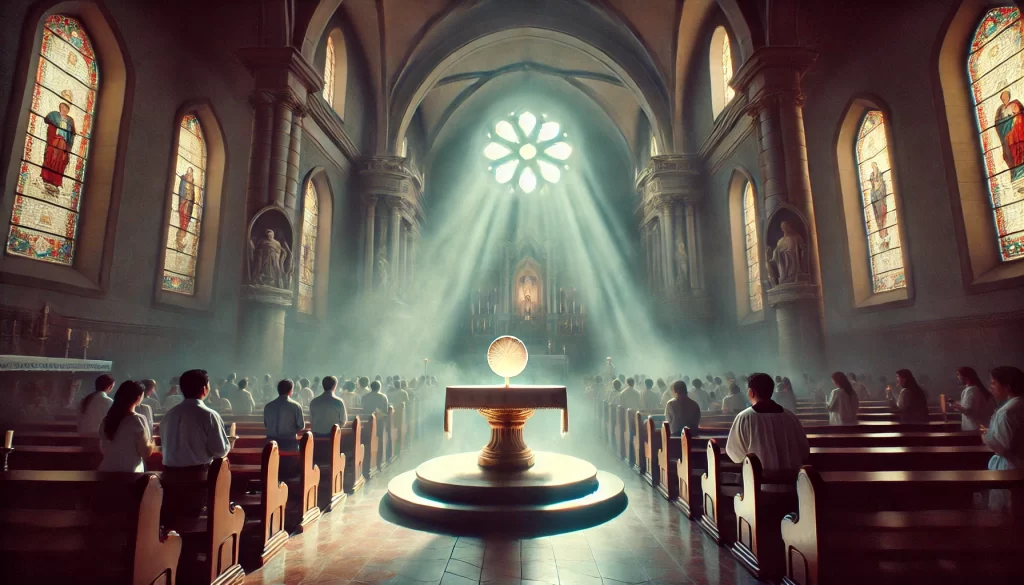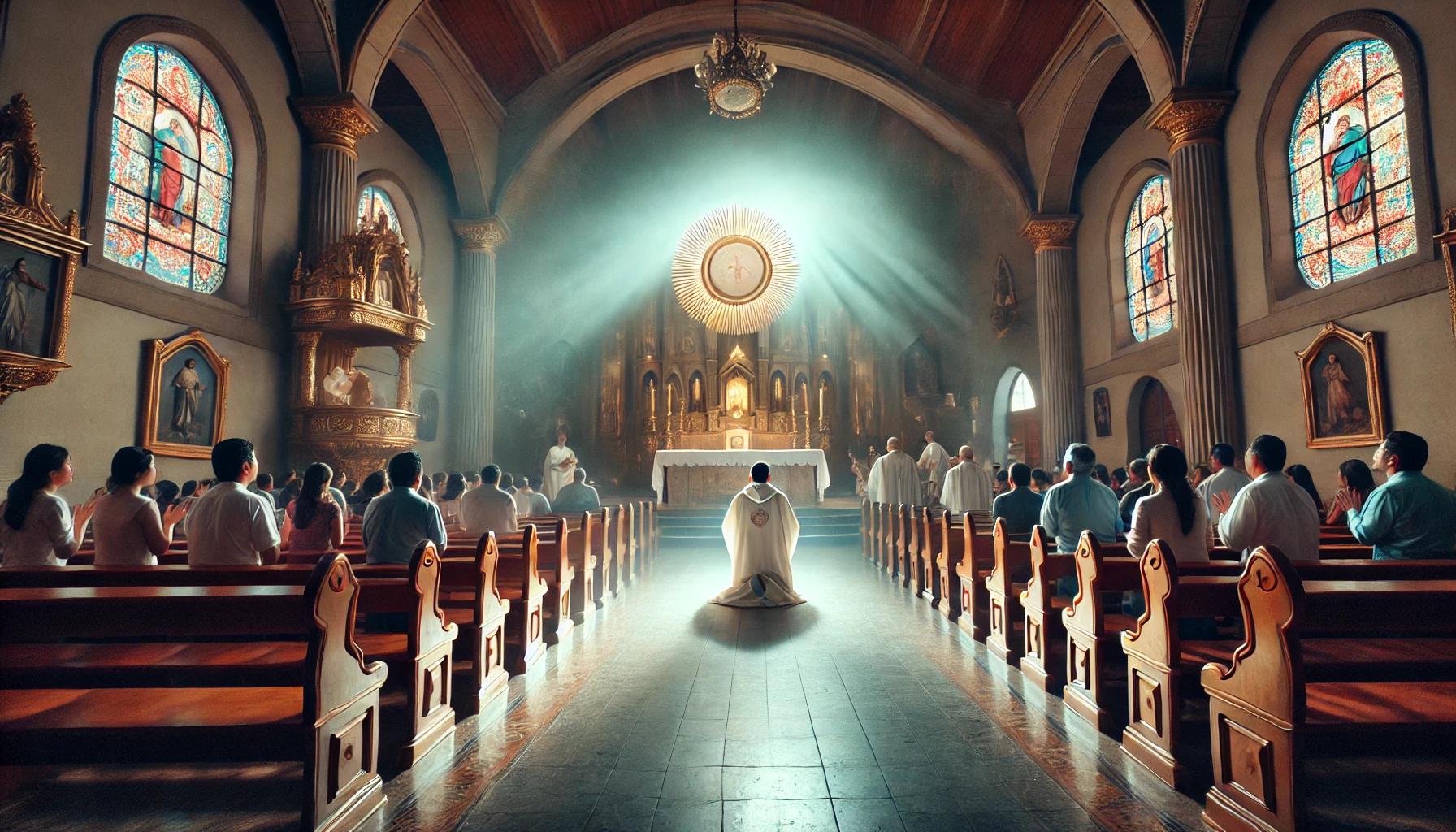A Mystical Encounter Captures Global Attention
In the quaint town of Zapotlanejo, nestled in the Mexican state of Jalisco, an extraordinary event has gripped the attention of believers and skeptics alike. On July 22 during a routine Eucharistic exposition at Our Lady of the Rosary parish, a Eucharistic host allegedly began to beat like a human heart. This inexplicable occurrence, witnessed by numerous parishioners and recorded on video, has since gone viral, sparking fervent discussions about its authenticity and significance.
The Event Unfolds
Father Carlos Spahn, an Argentinian priest, presided over the Mass and Eucharistic exposition on that fateful day. As he completed the prayers for the exposition and moved towards the sacristy, the host, displayed in a monstrance, began to pulsate rhythmically. The phenomenon lasted for about 20-30 seconds, during which the host’s movement was captured on multiple cell phones by the astonished attendees.
“I couldn’t believe my eyes,” Father Spahn later recounted. “It was as if the host had come to life, beating just like a human heart.”
The Medical Analysis
In an attempt to understand the event, a local doctor was asked to analyze the video footage. According to the doctor’s assessment, the movement of the host mimicked the pulsation of a human heart. This finding has added a layer of scientific intrigue to the incident, leading some to speculate about its miraculous nature.
“The beating pattern observed in the host is consistent with that of a human heart,” the doctor explained. “It’s an extraordinary occurrence that challenges our understanding of natural phenomena.”
A Divine Sign?
For many believers, the beating Eucharistic host is seen as a divine sign. Such miracles, they argue, are manifestations of the divine presence, meant to reinforce faith and inspire devotion. The fact that the host’s pulsation was not observed by everyone present, but only by a select few, has further fueled the belief in its supernatural origin.
“This selective visibility suggests that the event has a divine origin,” Father Spahn noted. “If it were a natural occurrence, everyone would have seen it simultaneously.”

The Viral Spread
The video of the pulsating host quickly spread across social media platforms, garnering millions of views and sparking widespread discussion. While many viewers expressed awe and wonder, others approached the video with skepticism, questioning its authenticity and calling for further investigation.
“The internet has given us a platform to share and witness such extraordinary events,” said one social media user. “But it also makes it easier for misinformation to spread. We need to approach this with both faith and a critical mind.”
Historical Context of Eucharistic Miracles
The Catholic Church has a long history of Eucharistic miracles, where the bread and wine used during Mass are believed to exhibit miraculous properties. One of the most famous cases is the Miracle of Lanciano, which occurred in the 8th century in Italy. During Mass, the consecrated host is said to have turned into actual flesh and blood. Scientific examinations in the 20th century confirmed that the flesh was cardiac tissue and the blood type AB, which remains a subject of awe and devotion to this day.
In more recent history, similar miracles have been reported worldwide, each reinforcing the belief in the real presence of Christ in the Eucharist. These events are often subjected to rigorous scrutiny by the Church, with investigations lasting several years before a verdict is reached.
The Church’s Stance
While the Church often takes a cautious approach to such claims, allowing for thorough investigation and validation, the beating host in Zapotlanejo has yet to undergo formal ecclesiastical scrutiny. Father Spahn has urged for patience and discernment as the Church authorities consider the event.
“I witnessed the event firsthand, but it’s important to approach this with caution,” Father Spahn emphasized. “The Church will conduct its investigation and, in time, determine the nature of what we experienced.”
A Community Transformed
Regardless of the final verdict, the event has already had a profound impact on the local community and beyond. Parishioners who witnessed the beating host describe it as a moment of deep spiritual awakening and renewal of faith.
“It was a sign of hope and reassurance,” said one parishioner. “In a world filled with doubt and uncertainty, this miracle reminds us of the divine presence among us.”
The Broader Implications
The beating Eucharistic host in Zapotlanejo has reignited conversations about the nature of faith, miracles, and the divine. It serves as a powerful reminder of the mysteries that lie beyond human understanding and the enduring belief in miracles that has shaped religious experiences for centuries.
As the video continues to circulate online, it invites viewers to reflect on their own beliefs and the possibility of the miraculous in everyday life. Whether seen as a divine intervention or an unexplained natural phenomenon, the beating host has undoubtedly left an indelible mark on all who have encountered its story.
The miraculous event in Zapotlanejo remains a topic of great fascination and debate. As the Church undertakes its investigation, the world watches with bated breath, eager to understand the true nature of this extraordinary phenomenon. In the meantime, the beating Eucharistic host stands as a symbol of faith and mystery, challenging us to look beyond the ordinary and embrace the possibility of the divine.
For further details and to view the video, visit EWTN Global Catholic Television Network.







